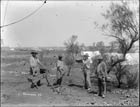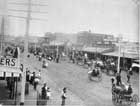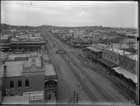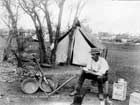Charles and Campbell Deland
 The Deland brothers came from Gawler in South Australia. Edward Campbell Deland (referred to as Campbell) arrived on the Eastern Goldfields in June 1895, aged 24. His younger brother, Charles, arrived in 1896, aged 19. While living on the goldfields, Campbell and Charles Deland described their experiences in letters they wrote to family and friends. These were later collected by Michael Best and published as A Lost Glitter.[7] The reasons Campbell and Charles left South Australia are not made explicit in their letters, but it is likely they came to the goldfields seeking wealth, experience and adventure, like many others from the depressed eastern colonies.[8]
The Deland brothers came from Gawler in South Australia. Edward Campbell Deland (referred to as Campbell) arrived on the Eastern Goldfields in June 1895, aged 24. His younger brother, Charles, arrived in 1896, aged 19. While living on the goldfields, Campbell and Charles Deland described their experiences in letters they wrote to family and friends. These were later collected by Michael Best and published as A Lost Glitter.[7] The reasons Campbell and Charles left South Australia are not made explicit in their letters, but it is likely they came to the goldfields seeking wealth, experience and adventure, like many others from the depressed eastern colonies.[8]
When Campbell first arrived on the goldfields he stayed in Southern Cross for three months, where he worked as a bookkeeper for a local businessman and his wife, Mr and Mrs Rockcliffe. He then set off for Kalgoorlie where he pursued various business interests, including a bakery with Jim Ellis, a man whom he met in Southern Cross.
 Charles arrived in Kalgoorlie at the end of February 1896 and initially worked with Campbell in the bakery. Later, though, he worked in stores at Mt Ida, 120 kilometres north-west of Menzies, and then at Yerilla, east of Menzies. In June 1896 the bakery business collapsed and Campbell spent the next twelve months settling his affairs in Kalgoorlie. Meanwhile, Charles returned to South Australia at the end of 1896 and became engaged to Effie Wylie. Then, in January 1897, he left South Australia again for the goldfields and joined Campbell on the mining leases, where they tried their luck as gold prospectors. They both returned to South Australia later in 1897.
Charles arrived in Kalgoorlie at the end of February 1896 and initially worked with Campbell in the bakery. Later, though, he worked in stores at Mt Ida, 120 kilometres north-west of Menzies, and then at Yerilla, east of Menzies. In June 1896 the bakery business collapsed and Campbell spent the next twelve months settling his affairs in Kalgoorlie. Meanwhile, Charles returned to South Australia at the end of 1896 and became engaged to Effie Wylie. Then, in January 1897, he left South Australia again for the goldfields and joined Campbell on the mining leases, where they tried their luck as gold prospectors. They both returned to South Australia later in 1897.
Viewing the Landscape
 The Deland brothers initially observed and responded to the semi-arid landscapes of the goldfields in ways that were typical of European responses to Australian deserts in the nineteenth century. They saw the desert as a uniform expanse of flat, empty plains. Aboriginal people were aware of variations in the flora and topography of the deserts, but European explorers did not notice these differences. However, after Charles and Campbell had spent some time prospecting and camping they became familiar enough with the terrain to see that it was not featureless and dull, and they began to appreciate aspects of their desert environment.
The Deland brothers initially observed and responded to the semi-arid landscapes of the goldfields in ways that were typical of European responses to Australian deserts in the nineteenth century. They saw the desert as a uniform expanse of flat, empty plains. Aboriginal people were aware of variations in the flora and topography of the deserts, but European explorers did not notice these differences. However, after Charles and Campbell had spent some time prospecting and camping they became familiar enough with the terrain to see that it was not featureless and dull, and they began to appreciate aspects of their desert environment.
Soon after he arrived Charles commented on the sameness of the country and he seemed largely ignorant of the wildflowers that bloom in the spring:
Of flowers there are none except perhaps a minute one on the trees & bushes at seeding time. The scrub is monotonous & so similar that it is impossible to travel other than by the compass as landmarks there are none...[9]
Away from the towns though, where the eucalypt woodlands had not been cut for timber, the country was more attractive to Europeans and it was particularly pleasing after good rains. After a trip in September 1896 from Kalgoorlie to Broad Arrow (40 kilometres north of Kalgoorlie) and Hayes New Find (60 kilometres north east of Kalgoorlie) Campbell remarked:
I was very much surprised & pleased with all the country I saw. The Lakes are splendid, magnificent sheets of water... The country out in these back districts is simply lovely now, wild flowers in every direction, beautiful grasses and with the bright black Iron stone beads which cover the surface, the white quartz reef here & everywhere and the many coloured lodes & formations with the bright green trees & bushes above, the country is a perfect picture.[10]
 In mid 1897 Campbell and Charles left their work in town and went prospecting. While living on the fields the brothers had fewer comforts and in many ways life was harder, but they enjoyed the relative freedom of this lifestyle and believed that being outdoors among nature was a positive, virtuous experience. It also provided a means of escaping from the pressures and constraints of society. In a letter to his fiancee, Effie Wylie, Charles expressed his delight with living close to nature. He retired at sunset and rose with the call of the birds and the dingoes and took pleasure in being in tune with the rhythms of night and day. Similarly, Campbell wrote of his enjoyment of living outdoors:
In mid 1897 Campbell and Charles left their work in town and went prospecting. While living on the fields the brothers had fewer comforts and in many ways life was harder, but they enjoyed the relative freedom of this lifestyle and believed that being outdoors among nature was a positive, virtuous experience. It also provided a means of escaping from the pressures and constraints of society. In a letter to his fiancee, Effie Wylie, Charles expressed his delight with living close to nature. He retired at sunset and rose with the call of the birds and the dingoes and took pleasure in being in tune with the rhythms of night and day. Similarly, Campbell wrote of his enjoyment of living outdoors:
I have quite got to like it, the going to bed early. The beautiful fresh night air and day and being up at least half an hour before the sun of a morning, it is altogether a pleasant free life and I would rather now sleep in a tent than in a stuffy iron or wood house...[11]
Finding Home?
 It is evident from their letters that the Deland brothers came from a close family with a strict moral code and they missed their home in Gawler and were lonely. This is not unexpected but their attachment to family was so great that their accounts of their experiences on the goldfields were filtered through an awareness of how their parents would respond. For example, when Charles joined Campbell in Kalgoorlie, Campbell was aware that his parents would very much feel the loss of their sons and he wrote to reassure them that their home was with them in Gawler:
It is evident from their letters that the Deland brothers came from a close family with a strict moral code and they missed their home in Gawler and were lonely. This is not unexpected but their attachment to family was so great that their accounts of their experiences on the goldfields were filtered through an awareness of how their parents would respond. For example, when Charles joined Campbell in Kalgoorlie, Campbell was aware that his parents would very much feel the loss of their sons and he wrote to reassure them that their home was with them in Gawler:
I do hope you will not feel the Gap that we two boys have made, too much. You may be sure that we shall both do our best to do what we can so as to return to you as soon as we can. This place will never be a home.[12]
 The photograph titled 'Letter from home', from the collection of Edward Campbell Deland, shows a miner with a 'letter from home' and it is easy to imagine that this was Charles or Campbell, sitting in their camp and reading letters from family and friends. So, although the Deland brothers found beauty in the landscapes of the goldfields during spring and were impressed by the land's gold-bearing capacity, their connections to the land were tenuous. They made homes in the towns and enjoyed their lifestyle while prospecting, but they did not feel that they belonged there. Perhaps this can be partially explained by their short stay in the goldfields, by their peripatetic lifestyle and also the strong connections they felt to their family back in South Australia. We have to conclude, though, that Charles and Campbell did not find 'home' on the goldfields.
The photograph titled 'Letter from home', from the collection of Edward Campbell Deland, shows a miner with a 'letter from home' and it is easy to imagine that this was Charles or Campbell, sitting in their camp and reading letters from family and friends. So, although the Deland brothers found beauty in the landscapes of the goldfields during spring and were impressed by the land's gold-bearing capacity, their connections to the land were tenuous. They made homes in the towns and enjoyed their lifestyle while prospecting, but they did not feel that they belonged there. Perhaps this can be partially explained by their short stay in the goldfields, by their peripatetic lifestyle and also the strong connections they felt to their family back in South Australia. We have to conclude, though, that Charles and Campbell did not find 'home' on the goldfields.
Page last updated: Thursday 23 February 2012 by Illona Tobin Asset ID 44569
Editors for this page nick 2nd account
login




